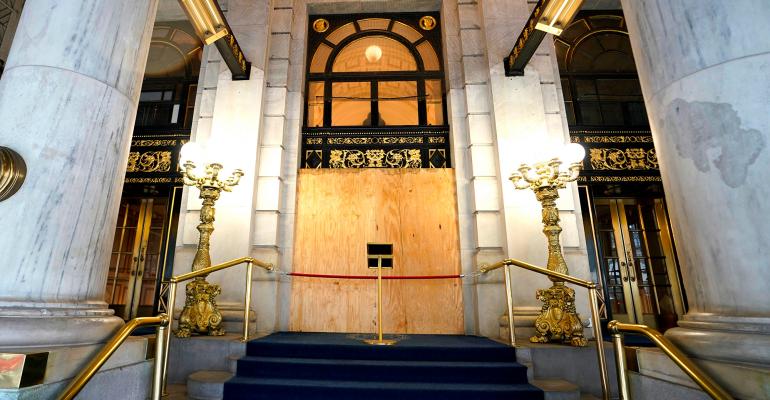(Bloomberg)—At Manhattan’s hotels, there are few signs of the festive fervor that the holiday season typically brings.
The Plaza is shuttered. So is the St. Regis, whose famed King Cole Bar is usually a source of Christmas cheer. Even the hotels that are open are watching occupancies drop as surging Covid-19 cases put weary travelers on guard.
“We don’t expect business volume to exceed 20%,” said Francois-Olivier Luiggi, general manager at the Pierre, across Fifth Avenue from Central Park. “This seems to be the most anyone can do on average.”
A dreary holiday season is the latest blow in a year that is widely viewed as the worst ever for the modern hotel industry. Across the U.S., revenue per available room -- a gauge of price and occupancy -- fell 57% last week, the second-steepest year-over-year decline since June, according to lodging-data firm STR. Things were even worse in New York, where the measure plunged 86% to $45.39.
That’s deepening a crisis for hotels at a time visitors usually flock to Manhattan to shop Fifth Avenue, admire the Rockefeller Center tree and and cram Times Square for the New Year’s Eve ball drop. And as Mayor Bill de Blasio warns New Yorkers to gird for another shutdown, the city’s $70 billion tourism industry stands to take an even bigger hit from the pandemic.
Already, indoor restaurants are closed and winter weather is curtailing many outdoor activities. Even as a coronavirus vaccine offers promise of a recovery, hotel owners are struggling to cover fixed costs while key sources of demand -- from Broadway patrons to corporate travelers -- remain at home.
Last week, the Marriott Marquis, one of New York’s largest conference hotels, said it was permanently terminating more than 800 workers. Others may soon follow. Expenses for debt service and property taxes are mounting, and a recent labor ruling saddled owners with hundreds of millions of dollars in severance payments.
“We’ll have a comeback eventually, no question,” said Vijay Dandapani, chief executive officer of the Hotel Association of New York City. “But I would not be shocked if north of 25% of hotels close permanently.”
The city’s famed luxury hotels face a unique set of challenges. They’re more expensive to run, and they’re loathe to lower prices too far and spoil their air of exclusivity. Operating during a pandemic means finding ways to convince customers that they’re providing value, even while safety concerns mean limiting amenities, from room service to spa hours.
Many hotels have preferred to stay closed, saving money on staff and utilities and using the opportunity to make renovations. Renowned Midtown properties like the Peninsula and the Mandarin Oriental have been shut for months. The same goes for the Edition, near Madison Square Park.
The Pierre, which started accepting bookings in September after a months-long hiatus, has been experimenting with promotions to lure well-to-do travelers. One offer encourages families to reduce exposure to strangers by booking an entire floor, while another includes a $500 gift card to Saks Fifth Avenue.
‘Toughest Year’
Those that have reopened face challenges turning a profit, despite catering to a customer base that is willing to pay high rates for posh accommodations. The Baccarat Hotel has been commanding average daily rates of about $1,000 for rooms and $5,000 for suites since reopening in October after an extended shutdown.
Occupancy rates are down, though, and while the hotel is covering some fixed costs, it’s not making a lot of money, said Arash Azarbarzin, president of SH Hotels & Resorts, which operates the Baccarat. Instead, reopening has helped management gain insights into customer behavior that may help the company plan for the highly uncertain year ahead.
“This has been the toughest year in my career to predict what’s going to happen,” Azarbarzin said. “Forget 2021, but just forecasting the next two weeks is a challenge.”
When the managers of the Four Seasons New York Downtown began planning to reopen the hotel in September, occupancy rates were hovering around 40% on weekends. Now, demand has plummeted. Bookings are coming at the last minute, adding challenges to setting staffing levels and keeping the pantry stocked.
General Manager Thomas Carreras is still optimistic. He’s hoping that guests coming into Manhattan for holiday shopping will prefer SoHo boutiques over Midtown department stores, making his hotel’s location a selling point.
And perhaps this unusual holiday season will help the property create memorable experiences to form long-term bonds with guests -- especially since low occupancy rates mean staff can pay the clientele extra attention.
“We have turned into a small boutique hotel, and we know each of our guests by heart,” Carreras said. “In many ways, it’s the best time to look after people.”
--With assistance from Nikki Ekstein.
© 2020 Bloomberg L.P.





